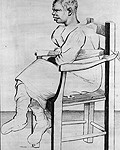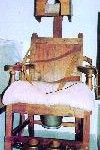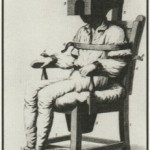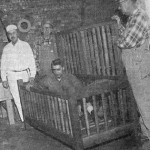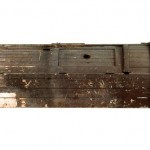Historically, the treatment of the insane has been riddled with abuse, neglect, and indifference. Restraints were particularly abused, as attendants restrained patients for a variety of reasons: sometimes for safety, sometimes for convenience, and sometimes for punishment. Below are a few popular methods:
1. The crib was a box with a cover and crossbars in which a patient had to lie. Often called a Utica crib for the asylum where it originated, this device was discontinued around 1887.
2. A straitjacket is a shirt-like garment with extra-long sleeves that can be tied at the back of the wearer, whose arms are criss-crossed in front. Many times the ends of the sleeves were sewn shut. Wearing a straitjacket for any length of time can cut off circulation to some extent.
3. Leg locks and chains secured patients to walls and chairs.
4. Dr. Rush developed a tranquilizing chair that restrained an agitated patient in order to slow down the flow of blood.
5. Leather muffs restrained hands by enclosing them in a tight one-piece leather cover. The patient’s hands might be placed in front or in back.
6. A restraining sheet was a fabric sheet with fasteners along the sides. Each fastener was secured to a portion of the bed frame, with the prone patient confined to the space between the mattress and the sheet.
__
______________________
_________________________________

